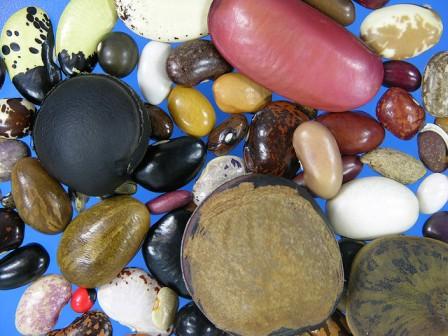Improving tropical legume productivity for marginal environments in sub-Saharan Africa  and South Asia
and South Asia
Legumes play an important role in agricultural production systems worldwide by providing a rich source of protein and oil for the poor, and by enriching the soil where they are grown. Legumes have a symbiotic relationship with a class of soil bacteria called 'rhizobium' that attach to the roots of these crops, form nodules, and convert useless nitrogen from air into useful nitrates that the plant can use for growth and the production of proteins. The rotation of legumes with cereal crops is an important strategy for building soil fertility and health in regions such as sub-Saharan Africa (SSA), where soils have been depleted of nitrogen and organic matter.
Grain legumes are grown globally on 71.8 million hectares, with half being planted in Asia and one-quarter in Africa. Legumes are often considered the 'meat of the poor' as they are used as a substitute for meat and milk. All grain legumes have considerably higher value in grain markets than cereals, and are an important source of income, especially for women farmers. However, legumes are less than half as productive as cereals, in part due to losses caused by pests and disease. Legumes are also generally susceptible to drought and heat stress, with notable exceptions being cowpeas and pigeonpeas.
For the poorest people, legumes are often the only sources of protein and fat, and are also a rich source of essential vitamins and minerals. In SSA where hunger and malnutrition threaten the lives of an estimated 11 million people, consumption of legumes is higher than anywhere else in the world, except for North and South America. Legumes also generally attract higher market prices than other staple crops, making them an important source of income for farmers, with the added advantage of their resilience to grow on impoverished soils.
However, despite their importance, legume breeding has not received adequate attention. SSA countries lack varieties for different seasons and different cropping systems. Consequently, legume productivity in this region is the lowest in the world, attaining a mere 10–50 percent of yields obtained under optimal conditions.
The Legumes Research Initiative (RI) focuses on improving the productivity of four legumes of importance to food security and poverty reduction in SSA, South Asia and Central America (beans, chickpeas, cowpeas and groundnuts) by providing solutions to overcome biotic and abiotic stresses that afflict them. The RI incorporates the Tropical Legumes I project (TLI), which was initatied in 2007. TLI is led by GCP, while its twin project, Tropical Legumes II (TLII), is led by the International Crops Research Institute for the Semi-Arid Tropics (ICRISAT).
Funding: In Africa, the Legumes RI is mainly funded by the Bill & Melinda Gates Foundation through TLI, with additional funding from the European Commission, the Department for International Development (UK) and the World Bank, who also fund the projects in Central America. The Indian chickpeas component is funded by the Department of Biotechnology of the Government of India. See full listing of GCP funders.
For more information on legumes, including feature stories, videos, podcasts and blogposts in everyday language, visit our Legumes InfoCentre.
Facts & figures on legumes
Learn more about the four legumes we work on through the IBP website
beans | chickpeas | cowpeas | groundnuts
Resources and networks for researchers
- How to phenotype the following legumes for drought (open-access book chapters in e-book format)
beans | chickpeas and pigeonpeas | cowpeas | groundnuts - Join our legume communities of practice on the IBP website
beans | chickpeas | cowpeas | groundnuts - Browse and download information and genomics resources for each of the four legumes through the IBP website
beans | chickpeas | cowpeas | groundnuts - Through our Product Catalogue, browse what we offer for
beans | chickpeas | cowpeas | groundnuts


